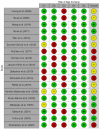Single Nucleotide Polymorphisms and Dental Fluorosis: A Systematic Review
- PMID: 36354656
- PMCID: PMC9689045
- DOI: 10.3390/dj10110211
Single Nucleotide Polymorphisms and Dental Fluorosis: A Systematic Review
Abstract
Genetic factors contribute to susceptibility and resistance to fluoride exposure. The aim of this systematic review was to identify alleles/genotypes of single nucleotide polymorphisms (SNPs) associated with dental fluorosis (DF) and to identify them as protective or risk factors. PubMed, ScienceDirect, Cochrane Library, Scopus and Web of Science were searched for articles; the last search was performed in August 2022. Human studies that analyzed the relationship between SNPs and DF published in English were included; systematic reviews and meta-analyses were excluded. Methodological quality was graded using the Joanna Briggs Institute checklist and risk of bias was assessed using the Cochrane Collaboration's tool. Eighteen articles were included, 44% of which showed high methodological quality and data from 5,625 participants aged 6 to 75 years were analyzed. The SNPs COL1A2, ESR2, DLX1, DLX2, AMBN, TUFT1, TFIP11, miRNA17, and SOD2 were considered risk factors, and ESR1, MMP20, and ENAM were considered protective factors. In conclusion, there are alleles and genotypes of different single nucleotide polymorphisms involved in increasing or decreasing the risk of developing dental fluorosis.
Keywords: dental fluorosis; gene; polymorphism.
Conflict of interest statement
The authors declare no conflict of interest.
Figures




References
-
- Yadav K.K., Kumar S., Pham Q.B., Gupta N., Rezania S., Kamyab H., Yadav S., Vymazal J., Kumar V., Tri D.Q., et al. Fluoride contamination, health problems and remediation methods in Asian groundwater: A comprehensive review. Ecotoxicol. Environ. Saf. 2019;182:109362. doi: 10.1016/j.ecoenv.2019.06.045. - DOI - PubMed
-
- World Health Organization . Guidelines for Drinking-Water Quality: Fourth Edition Incorporating First Addendum. WHO; Geneva, Switzerland: 2017. [(accessed on 10 September 2021)]. Available online: https://www.who.int/publications/i/item/9789241549950. - PubMed
-
- Abanto Alvarez J., Rezende K.M., Marocho S.M., Alves F.B., Celiberti P., Ciamponi A.L. Dental fluorosis: Exposure, prevention and management. [(accessed on 15 September 2021)];Med. Oral Patol. Oral Cir. Bucal. 2009 14:103–107. Available online: http://www.medicinaoral.com/pubmed/medoralv14_i2_pE103.pdf. - PubMed
Publication types
Grants and funding
LinkOut - more resources
Full Text Sources
Miscellaneous

